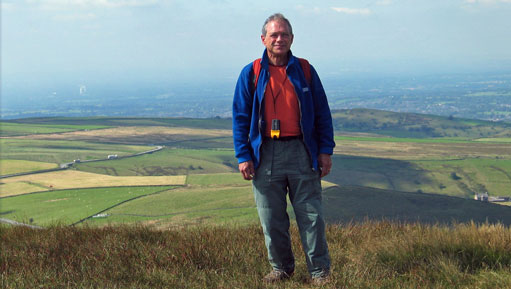Eric Eisenhandler
26 January 2009 | By

Even after 40 years living between Britain and Geneva, New York is still audible in the voice of Eric Eisenhandler. He grew up in the Bronx – “the North Bronx” he quickly corrects, lest we imagine the violence and urban decay that South Bronx came to symbolize.
While the US isn’t well-known for focused studies in secondary schools, he attended the Bronx High School of Science, “as many nerdy people do,” he adds. By the time he had finished his PhD at Cornell University, he had married his wife, Claire, who had also studied physics. He has worked at Queen Mary College, later renamed Queen Mary, University of London, since he earned his doctorate.
Claire became a scientific copy editor rather than a researcher, currently editing science and medical books for Oxford University Press. Eric shares her interest in writing and style, so he became involved with the style guide that will bring cohesion to the many English-language papers that ATLAS physicists will write in the coming years.
“The idea was floated by Norman McCubbin, who knew of my interest in such things,” Eric retells. He proposed the structure and contents to the Publications Committee. While it incorporates suggestions from the Publications Committee and others who saw it along the way, the ATLAS Style Guide is essentially Eric’s brain child. The ATLAS Glossary, originally part of the Style Guide, now incorporates several others in a stand-alone Twiki, available for editing by collaborators.
His involvement with ATLAS started before the project was even named, before the merging of the EAGLE and ASCOT experiments. Collaborating with the University of Birmingham and Rutherford Appleton Laboratory, Eric was initially slated to spend only five per cent of his time on EAGLE. “It rapidly expanded to be much more than 100 per cent of my time…well, you know what I mean,” he says, laughing.
Eric spent a decade as Project Leader of the Level-1 Calorimeter Trigger, from 1996 to 2006. He prefers the term ‘coordinator’, “because I was working with a lot of very bright, enthusiastic people. My job was to make sure it all merged together and went somewhere,” says Eric. “I didn’t see myself as a charismatic leader or anything like that.”
The people he worked with, who hailed from some 16 countries, account for much of his enjoyment as Project Leader. Eric found the goals of the Level-1 Calorimeter Trigger equally exciting, as the team needed to create a system that would quickly eliminate 99.8 per cent of the collisions while keeping all potentially interesting events. “What's rejected is gone,” he elaborates. “But we must not reject the exciting physics that is predicted to occur perhaps once an hour, or once a week.”
After all these years in the field, and all the build-up to the LHC, Eric finds it difficult to quit particle physics cold turkey. He’s been easing his way into retirement since September 2007, officially “half-retired” since then. However, he worked more or less full-time even through autumn 2008, becoming more like half-time this winter. He begins to wind down, working fewer hours and taking an interest in his community’s green initiative.
While his village of Blewbury is in the English countryside, it boasts three national labs in close proximity, and many residents are scientists who commute to them. “Some of the ‘yokels’ you meet are amazingly well educated,” Eric laughs.
Perhaps the science-minded population helps account for the extensive green energy activities in a village of just over 1500 people. Eric wrote half of the website, and he’s been involved in raising awareness about efficient living. He says: “We’ve taken thermal pictures of people’s houses to see where the heat’s leaking out.”

A thermal image of the Red Lion Pub in Blewbury
Eric believes that Britain is a great place to travel in and from. He and Claire have enjoyed traveling in Europe and beyond, visiting Italy and Spain as well as India and Sri Lanka among their destinations. One of their favorite ways to get to know a place is through walking tours, hiking from hotel to hotel with luggage transported between stops. Eric clearly isn't one to simply kick back and relax, either on vacation or in his partial retirement.



